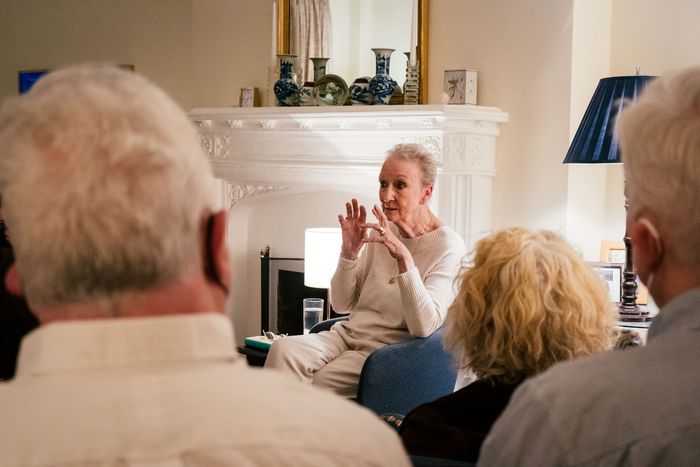
It has been almost a year since Joan Didion died, and she — or at least some gentler, more good-natured version of her — is haunting us still. Right now, that Didion, played by Kathleen Chalfant, is appearing in a beige sweater in various tasteful living rooms around the city, telling the same sad stories adapted for the stage from her book The Year of Magical Thinking.
When I arrived early at last Friday night’s performance, in a Nancy Meyers–worthy living room in Greenwich Village, Chalfant was fussing over a vase of fresh lilies. The director, Jonathan Silverstein, was testing out the sight lines from plush couches and creaky dining-room chairs as the stage crew fretted that the space was too “stuffy.” The co-op owner and our host for the evening’s semi-séance, Rose Courtney, was responding to all of their urgent requests: “Can I have some hot water?” and “Can you move that?” and “Can I borrow you for just two minutes?” She’d already sent her 12-year-old son, along with their fluffy dog, to his bedroom, with instructions to finish his homework and avoid flushing the toilet or banging on his new drum set for the next couple of hours.
Courtney is one of 17 benevolent theater lovers who have opened their homes to this comfy production of The Year of Magical Thinking, as well as a couple of community centers. It’s the first New York production since the 2007 Broadway run of this one-woman show, in which a gray-haired avatar of the writer tells the story of losing her husband, the writer John Gregory Dunne, and their daughter, Quintana Roo, within two years. Courtney is a former actor and playwright and current board member of the Keen Theater Company, which is producing this time. “I can’t think of a better use for my home. Theater is what I pin my hopes on now. It’s been a very challenging time in the city,” she told me. “I’d so much rather be doing this than throwing a party.” (Masks are required, and no one touched the half-empty bottle of Pinot Noir I spotted on the kitchen counter.)
“The only challenge is the willingness to hand over your space, to give over control of your home. They moved everything in my living room,” Courtney admitted, taking a quick deep breath. “That’s all okay.” She put her white Birkenstock down with the crew only once. “They were asking me, ‘Can we move this table with a tablecloth on it?’ I said I don’t think you should, ’cause there are cans of paint under there. Storage in New York is … ugh.” (Courtney left a pair of her loafers near the French door to the bedrooms, where a “Dressing Room” sign had been taped to the glass, so the “set” would feel lived-in.)
It’s a really nice apartment. Courtney tells me she found it in the real-estate ads of the New York Times 20 years ago, when she was in her 20s. It seems like a fairly demure place, although apparently the artist Max Ernst’s widow hosted rowdy salons there, much to the co-op board’s irritation. Courtney didn’t feel the need to alert them about this evening’s show. “I don’t think anyone will mind,” she said hesitantly, before gently requesting that the door girls and their clipboards stand out of sight of the doorman. “By the time anyone finds out, we’ll be in process.”
As you might expect, the guests — mostly understatedly stylish middle-age women and gays of varying ages — were well-behaved, arriving at 7:30 sharp, delivered in batches by a cheery elevator operator. An older woman in a paisley blouse who plopped down on a couch in front of me told me she’d secretly hoped one of the guests would get COVID and open up a spot for her husband. Then she got distracted by the crown molding. I observed the woman next to her, in a voluminous turtleneck, text someone to say: “We are sitting in a random living room in Greenwich Village,” before suggesting they meet up afterward for “a quick hug.” (The play is pretty dismal stuff, after all.) When a gay couple squirmed in between them, one commented, “It’s like being at SeaWorld.”
So it’s quite … intimate. That solves one problem that affected the 2007 Broadway production, staged in a theater with a capacity of 766. And Chalfant — though she is certainly less imposing than the towering and robust Vanessa Redgrave — doesn’t look much like the birdlike, fragile Didion, who once wrote, “My only advantage as a reporter is that I am so physically small.” (In Vanity Fair earlier this year, Lili Anolik revealed that Didion’s party-girl writer friend Eve Babitz once wrote her in a spicy letter, “Would you write what you write if you weren’t so tiny, Joan?”)
This Joan, Chalfant, is a presence, strutting into the living room at the start in sunglasses and beige the same color as the walls, with a dry demeanor that Silverstein is hoping gets closer to the real woman. “Kathy has a sort of, shall I say, patrician sternness,” he said, then corrects himself. “Stern is maybe too hard a word — she has a real clarity about her. I feel like that is very Joan Didion: very clear-eyed, takes no b.s. The other thing she has is a certain hard-won warmth to her. I really believe that she gives you some hope in this version.”
And she does, because this is theater. If it were the resurrected Joan Didion standing in front of you, she might not be so reassuring. This is the woman who wrote in one of the last pages of her book, “I look for resolution and find none,” the one whom New York’s Boris Kachka’s meetup with in 2011 was, he wrote, “like tiptoeing across a just-frozen pond filled with beautiful sharks. You look down and pray the ice will hold.” (When Jonathan Van Meter visited her shortly after Dunne died, he wrote, “I stayed to make small talk for 20 minutes, but I could not wait to leave.”) Watching Chalfant felt like paying a visit to your coastal grandmother and listening to her life stories, except for all the details — the house in Malibu, the fabulous press trips — remind you how rarefied Didion’s life was. When you read Didion, it sometimes feels as though she might slap you; the actor who’s your host for the evening, the one everyone calls “Kathy,” would never.
After the show was over and all the guests had quickly and quietly filed back downstairs, Chalfant told me she understands the limits of trying too hard to embody the woman: “When we did the first preview, someone who I think might have known Joan Didion said they liked it, but they said, ‘You’re a little warm for Joan,’” she told me. “I was undone — oh, how am I going to do this. And then I realized that I was doing a play, not an impersonation.”
Twenty minutes later, the “re-zhuzhing” was complete, all of Courtney’s furniture returned to its usual places on the parquet floors. “Sweetie, you can come out now,” she called to her son and the dog, who each came bounding back into the living room. The literary conjuring over, Courtney was making what looked like a buttery panini in the kitchen with her partner, everything normal, prosperous, happy, and domestic again — which, it occurred to me as I took the elevator down, thinking through the play, was maybe the most chilling part of the evening. It’s exactly the kind of moment where Didion’s sad story begins.



